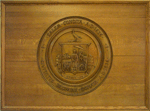Old Town Hall: Difference between revisions
No edit summary |
No edit summary |
||
| Line 12: | Line 12: | ||
==See Also== | ==See Also== | ||
*[http://www.salemoldtownhall.com/index.php?option=com_content&view=article&id=46:facts-about-the-old-time-hall&catid=25:the-project Salem Old Town Hall] photo and information | *[http://www.salemoldtownhall.com/index.php?option=com_content&view=article&id=46:facts-about-the-old-time-hall&catid=25:the-project Salem Old Town Hall] photo and information | ||
*[http://innopac.noblenet.org/record=b2096759~S24 Salem Historic District Study Committee Report] The Committee, 1969 | |||
Revision as of 10:09, 24 September 2010
Dating from 1816-17, Old Town Hall is the earliest surviving municipal structure in Salem. A Federal Style building, the Great Hall has been used as a public hall and contained Town offices until 1837. The first floor was designed as a public market. The building contains design elements attributed to Charles Bulfinch and Samuel McIntire. Saved from demolition in the 1930's by Salem preservation architect Philip Horton Smith, it underwent partial restoration in the 1970's.
The building has historical associations with Salem's prominent Derby family.
Presently, it is used as a public art space, in conjunction with Artists row in the adjacent Marketplace. The upstairs Great Hall is also used for dancing. Gordon College acting group History Alive uses it for their interactive show "Cry Innocent" about the witchcraft trials.
See Also
- Salem Old Town Hall photo and information
- Salem Historic District Study Committee Report The Committee, 1969
